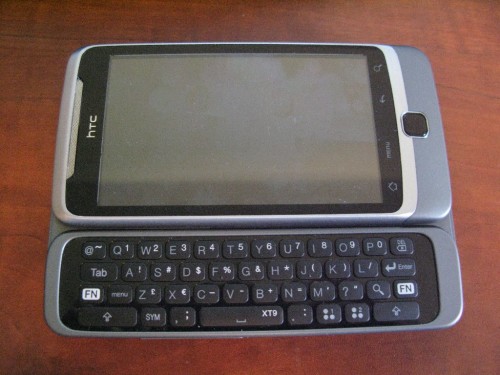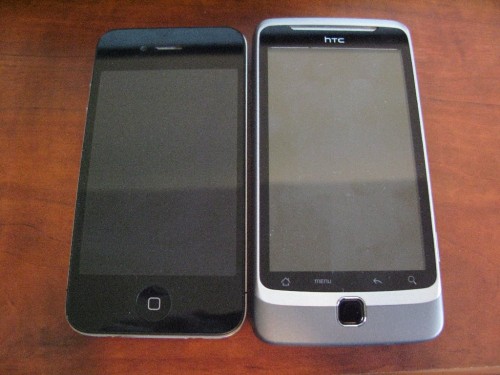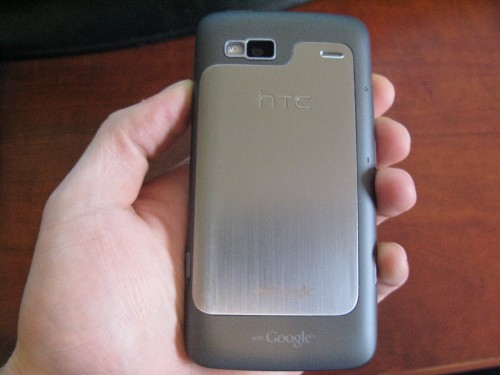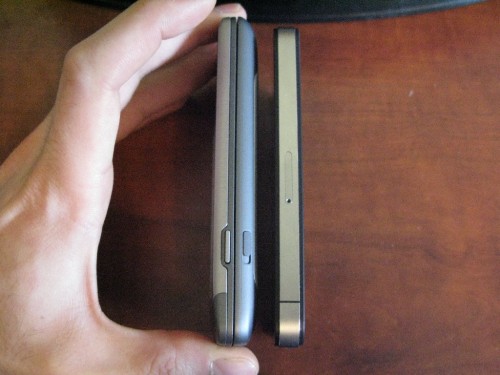ARTICLES:
Bell HTC Desire Z Review
HTC’s Desire Z is an imposing device. It is the rectangular big brother of the Nexus One, one that has taken up weightlifting and prone to drinking whey protein shakes. The body is heavy, almost overly so, but somehow when holding the phone in your hand its weight is forgotten in the carefully-chiseled aluminum face, attractive speaker grill, thoughtful button placement, and a keyboard hinge that’s worthy of a review all its own.
But the Desire Z is quirky: its QWERTY keys lie just above completely flat, and though rubberized, require too much force. It also may be a bit think for the average smartphone user. It is, however, the best Android device I’ve ever used, and I’ll break down my reasons for you. Read on:
Design
The first thing you’ll likely notice about the Desire Z is the screen. It dominates the front of the device in an austere, unobtrusive way. It’s not the biggest Android screen available: that role is reserved for its Desire HD counterpart, at 4.3″. But there is something attractive about the dual-tone brushed aluminum light grey/dark grey/black screen bezel. The screen is very flush, and the four relatively standard Android buttons are capacitive, not physical. They are far more responsive and accurate than the Nexus One’s notorious Home/Menu/Back/Search combo, and, along with the trackpad, come with a nice white backlight.
The addition of a dedicated camera shutter button is welcome, as is the backlit QWERTY keyboard. As stated above, the keyboard is a mixed bag, but certainly better than most landscape keyboards available for Android. In Canada we do not yet have the Droid 2, Epic 4G or myTouch Slide, but we do have the Milestone, which is known to have a pretty terrible keyboard, and I have to say the experience on the Desire Z is pretty positive. There is a nice rubbery click to each key, though it is often inconsistent as to how hard one must push down to activate it. It takes a bit of effort for each click, and until you get the hang of it and find a comfortable position for your hands to grip the sides of the phone, typing can be slow. After using it for a week or so, I actually prefer typing on the hardware keyboard than on any of the soft keyboards available to download. But if it’s 100WPM you want, don’t get this phone. This ain’t no BlackBerry.
The now-infamous hinge system is pretty ingenious. Aesthetically it looks very cool to see the top of the phone lifting away from the bottom, and the mechanism seems solid enough, but the reports of hinge looseness are just going to multiply as time goes on. When the keyboard is exposed, the screen portion rests atop the raised keyboard floor, so there is no chance of gravity pulling the LCD down. This ensures a smooth typing experience without the wobbling or shaking that one may experience with a sliding hinge, as I do with my BlackBerry Torch.
The battery cover is removable, but is only a portion of the entire back. This is both a blessing and a curse. The design looks fascinating, and is a nice solid chunk of light aluminum. But, I’ve had two Desire Z units, and have tried a G2, and all three of them had issues with the battery cover not fitting properly. There is often a millimeter or two between the cover itself and the rest of the backing, and causes the cover to dance around ever-so-slightly. When holding the phone in landscape mode to type, I often gripped the battery cover, and it indented as I would type. Very annoying. Luckily, this isn’t endemic, and I hope future batches of the phone fix the problem.
But overall this is decidedly not an iPhone 4. The design is mostly functional, and it is a bit heavy, chunky and utilitarian. If you’re into lightweight and sleek edges, check the HTC Desire (or the Desire HD when it inevitably arrives in Canada).
Link for Mobile Viewing
Performance
The Desire Z is a dream. In spite of its 800MHz Qualcomm 7230 Snapdragon processor, it performs better than the 1Ghz Nexus One, or, at times, the 1Ghz Galaxy S Vibrant. That is because the second-gen processor improves the efficiency of the processor, updates the GPU and improves power-saving features due to a smaller manufacturing process. It runs cooler, lasts longer, and performs better. Sounds like guys should aspire to do the same thing.
Basically, the Desire Z uses two things to its advantage: the increased performance of Android 2.2, and the maturity of its chipset. I can’t speak to true world performance over the Desire HD but this feels like the fastest Android device I’ve used.
Another huge, and I mean enormous, improvement over previous HTC-made Android devices, especially the Nexus One, is the extraordinary responsiveness of the screen. I cannot tell you how many times I almost threw my N1 down the stairs in frustration at its utter inability to accurately register my touches. Typing was a nightmare. The Desire Z has four touch points with which to work, and it shows. Multitouch is smooth and accurate; virtual typing on the excellent HTC_IME keyboard is a pleasure. I type faster with it than on my BlackBerry, and that’s something.
The phone supports HSPA+ speeds of 14.4Mbps, and though I didn’t get over 5Mbps down and 2Mbps up, it’s significantly more than the average I get on the Galaxy S Vibrant, whose theoretical maximum speed is half that of the Desire Z at 7.2Mbps. Real-world usage translates to better streaming video performance and faster downloads.
While the box says 1.5GB internal ROM, this is only partly accurate. The phone is the same internally as the T-Mobile G2; both phones have 4GB ROM, but only 1.5GB is accessible to the user. Hackers are, as we speak, diligently working to free the remaining amount from the clutches of the OS. More on hacking later. Note that Bell preloads the device with an 8GB microSD card, and Froyo allows one to install apps onto the card itself, so app storage should be a thing of the past.
The Screen
Simply, the screen is gorgeous. Its not Super AMOLED, or even plain AMOLED, which, to this author, is just fine. AMOLED displays got a lot of attention recently due to their excellent contrast and low power requirements. But the technology is in its infancy, and it shows: colours are washed out, and forget about using them in the sun. The Desire Z comes with a 3.7″ 800×480 pixel Super LCD capacitive touchscreen capable of producing 16million colours, and I’m pretty sure I’ve seen all of them*. Most importantly, reading large swaths of text is comfortable on a white background, and the blacks are deep.
Not everything about the screen is roses, though. I did notice, with my review unit, that there is some backlight bleeding from the top. You can’t see it in the daylight, but in a dark room, it’s quite noticeable. I only had this problem with one unit, and again, could be an aberration, but take a look at your unit before you start using it heavily.
(*This is not accurate.)
Sense
HTC included their newest Sense UI overlay on the Desire Z, and it’s mostly good. It replaces stock Android apps like the calendar, contacts, dialer and the keyboard, and includes some nice touches that I think should be included in stock Android.
There is now a recent apps list at the top of the notification bar, which is convenient. You scroll through it from left to right. Power saving features, such as turning off data connectivity at 15% battery to conserve, is a welcome addition. There are other thoughtful additions like an FM radio (which is conspicuously absent on stock Android, even though most devices support the functionality); built-in Facebook and Twitter integration through its FriendStream module; and a voice recorder, news reader, and various features that flesh out the Android experience, while adding a level of polish that doesn’t exist on other overlays such as Samsung’s TouchWIZ.
That isn’t to say Sense is perfect. I prefer the stock Android lock screen, and at times Sense gives the UI a cartoon-like feel. It’s also quite bloated: at any given time, there are upwards of 60 processes running in the background, eating up RAM and processing resources. Most of these are tiny, and don’t affect performance, but bloat is bloat. And, comparing the performance of the G2 to that of the Desire Z, the former is clearly faster, as there is less OS overhead. Just something to consider.
Mostly, however, the changes are welcome. Most people know that Android’s built-in Mail app is horrendous. It barely works, and forget about hooking it up to an Exchange server. HTC’s overhauled Mail app is quite capable, and worked great with my work’s Exchange server. Same with HTC’s Messaging app. As I said, there is a level of polish to Sense that many will appreciate. Would that its implementation of Copy & Paste be stolen by Google and put into all Android builds, this reviewer would be a happy camper. Alas…
One way that HTC plans to monetize its Sense platform is with its new web portal, HTCSense.com, where users can register their phone and enable backups of photos, messages and user data, which can easily be ported to another phone. Tracking is also available, so lost phones can be more easily found. More imporantly to the company is a move to sell Skins, Scenes, Widgets, Ringtones, Wallpapers, and whatever else they can push. While not the first company to do this, the fact that they may be opening up a separate App Store like Samsung did, and now ships with all their devices, is a sidestep, and moves the focus away from making good software.
Camera
The 5MP camera on the device is good; not great, but good. Its flash is superior in brightness to that of the Nexus One and original Desire, but that is a blessing and a curse, as indoors it often leads to washed-out subjects. Outdoors, the quality is what you’ve come to expect from HTC-sourced camera sensors. Colours are more accurate than those produced by the iPhone 4, but there is a softness to pictures I didn’t like. The performance of the camera, however, has been markedly improved by the new CPU, and it only takes a fraction of a second to auto-focus, snap your photo and move on to the next one.
Similarly, the camera sensor boasts 720p-capable video, and it will do in a pinch. But I’d much rather have an iPhone 4 around for video than this camera. Some videos had so much noise (not aural, but visual) it detracted immensely from the quality.
Take a look at a gallery of pics taken by the Desire Z.
Miscellaneous Ramblings
Much ado was made about the security features of the Desire Z and its ilk when they were released. In short, there is a built-in reset mechanism that prevents any permanent changes from being made to System files. That means that any alterations to the OS are not saved, and are removed when the phone reboots. HTC came under fire for this decision, but from a consumer perspective, it means that the phone is much more difficult to brick, or render useless from user intervention. It also means that it is very difficult to hack or root the phone to install custom ROMs or remove apps that came with the phone. The security has since been broken, and regular Android hacking has resumed, but it shows the direction that manufacturers are taking to prevent end users from altering the experience of their phones. It also questions the validity of Android as a strictly open codebase, as it’s now deemed OK to take it, stick a bunch of carrier-endorsed (read: worthless) apps on there, lock it up to prevent users from changing anything, and shipping it out. This isn’t the way a lot of people envisioned Android being. But it’s a philosophical question of vision vs. profit, and clearly the Nexus One, sold directly to consumers and without any such manufacturer locks, was not a successful business model, though at the moment Google still considers it their flagship phone, and it will received Android 2.3 first since it doesn’t need to go through carriers to get the update pushed.
Bell also includes some apps that cannot be removed from the phone without great difficulty: Kobo Books (good), Asphalt 5 (very good), TV&Radio (good), Zoompass (meh), GPS Navigator (Telenav, $10/month), Yahoo search (WHAT?!). There was a lot of talk about Verizon bundling Bing Search with their Android phones, and removing the ability to use Google as the default search engine on the phone. Bell hasn’t gone that far, and still includes the Google Search widget on the device, but Yahoo is preloaded on one of the homescreens. It would be nice to be able to delete these apps, but there presence is not all that surprising, and their selection not entirely unwelcome.
Battery
The 1300mAh battery lasts a while. The 800MHz processor is pretty easy on power consumption, and your device should last the day if you’re not updating Twitter/Facebook/RSS/Widgets every ten minutes. I found that surfing the web with Flash turned on eats up battery life, but that isn’t unexpected. I am impressed with the battery life, overall.
Last Thoughts
For me, it comes down to enjoyability. When I use a phone, I don’t want to think about all the problems, but rather whether I enjoy using it. Does the GPS work as described (see Galaxy S Vibrant)?; does the battery last the day?; is it comfortable in the hand; is it well-made (see Galaxy S again). A high-end phone isn’t merely about the hardware specs, but about the combination of design, function, performance and battery. The keyboard is a welcome addition to the phone and doesn’t add a ton of bulk. It’s weighty, but not uncomfortably heavy in the pocket. The screen is bright and readable in sunlight. The camera does an admirable job.
The points add up: the pros vastly outweigh the cons, and I will be making this my Daily Driver, so to speak. Kudos to HTC and to Bell for releasing the phone in Canada at a time where we are salivating over new devices, but rarely see a high-end Android device that isn’t made by Samsung. I expect the Desire HD will be released by Telus by the Christmas season, but until then, the Desire Z is easily the King of Android in Canada, and has my endorsement for the best Android device released to date.
The Desire Z is available from Bell for $129.95 on a 3-year term, or $499.95 without a contract.
-
http://www.thecellularguru.com/blog TheCellularGuru
-
David Dee













